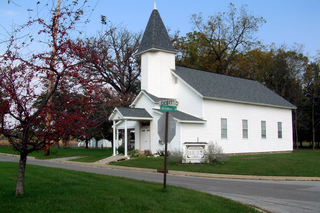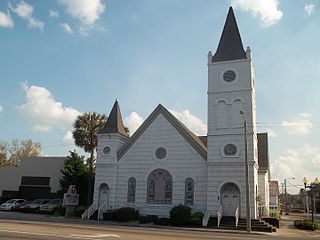Related Research Articles
Pentecostalism or classical Pentecostalism is a Protestant Charismatic Christian movement that emphasizes direct personal experience of God through baptism with the Holy Spirit. The term Pentecostal is derived from Pentecost, an event that commemorates the descent of the Holy Spirit upon the Apostles and other followers of Jesus Christ while they were in Jerusalem celebrating the Feast of Weeks, as described in the Acts of the Apostles.

Shango is an Orisha in Yoruba religion. Genealogically speaking, Shango is a royal ancestor of the Yoruba as he was the third Alaafin of the Oyo Kingdom prior to his posthumous deification. Shango has numerous manifestations, including Airá, Agodo, Afonja, Lubé, and Obomin. He is known for his powerful double axe (Oṣè). He is considered to be one of the most powerful rulers that Yorubaland has ever produced.

Oshun is an orisha, a spirit, a deity, or a goddess that reflects one of the manifestations of the Yorùbá Supreme Being in the Ifá oral tradition and Yoruba-based religions of West Africa. She is one of the most popular and venerated Orishas. Oshun is an important river deity among the Yorùbá people. She is the goddess of divinity, femininity, fertility, beauty, and love. She is connected to destiny and divination.

Orishas - correct spelling: singular - òrìṣà, plural - òrìṣàs - are divine spirits that play a key role in the Yoruba religion of West Africa and several religions of the African diaspora that derive from it, such as Cuban, Dominican and Puerto Rican Santería and Brazilian Candomblé. The preferred spelling varies depending on the language in question: òrìṣà is the spelling in the Yoruba language, orixá in Portuguese, and orisha, oricha, orichá or orixá in Spanish-speaking countries.

United Baptist is name of several diverse Baptist groups of Christianity in the United States and Canada.
The Apostolic Christian Church (ACC) is a worldwide Christian denomination from the Anabaptist tradition that practices credobaptism, closed communion, greeting other believers with a holy kiss, a capella worship in some branches, and the headcovering of women during services. The Apostolic Christian Church only ordains men, who are authorized to administer baptism, the Lord's Supper, and the laying on of hands.
Spiritual/Shouter Baptist Liberation Day is an annual public holiday celebrated in Trinidad and Tobago on 30 March. The holiday commemorates the repeal on 30 March 1951 of the 1917 Shouter Prohibition Ordinance that prohibited the activities of the Shouter or Spiritual Baptist faith.

The Yoruba religion, West African Orisa (Òrìṣà), or Isese (Ìṣẹ̀ṣe), comprises the traditional religious and spiritual concepts and practice of the Yoruba people. Its homeland is in present-day Southwestern Nigeria, which comprises the majority of Oyo, Ogun, Osun, Ondo, Ekiti, Kwara and Lagos States, as well as parts of Kogi state and the adjoining parts of Benin and Togo, commonly known as Yorubaland.
Afro-Trinidadians and Tobagonians are people from Trinidad and Tobago who are of Sub-Saharan African descent, mostly from West Africa. Social interpretations of race in Trinidad and Tobago are often used to dictate who is of West African descent. Mulatto-Creole, Dougla, Blasian, Zambo, Maroon, Pardo, Quadroon, Octoroon or Hexadecaroon (Quintroon) were all racial terms used to measure the amount of West African ancestry someone possessed in Trinidad and Tobago and throughout North American, Latin American and Caribbean history.
Siparia is a town in southern Trinidad, in Trinidad and Tobago, south of San Fernando, southwest of Penal and Debe and southeast of Fyzabad.
The culture of Trinidad and Tobago reflects the influence of Indian-South Asian, African, Indigenous, European, Chinese, North American, Latino, and Arab cultures. The histories of Trinidad and Tobago are different. There are differences in the cultural influences which have shaped each island. Trinidad and Tobago is an English-speaking country with strong links to the United Kingdom.
Religion in Trinidad and Tobago, which is a multi-religious country, is classifiable as follows:

The black church is the faith and body of Christian denominations and congregations in the United States that predominantly minister to, and are also led by African Americans, as well as these churches' collective traditions and members. The term "black church" may also refer to individual congregations, including in traditionally white-led denominations.
Aganju is an Orisha. He is syncretized with Saint Christopher in the Cuban religion known as Santería.

Religion of black Americans refers to the religious and spiritual practices of African Americans. Historians generally agree that the religious life of black Americans "forms the foundation of their community life". Before 1775 there was scattered evidence of organized religion among black people in the Thirteen Colonies. The Methodist and Baptist churches became much more active in the 1780s. Their growth was quite rapid for the next 150 years, until their membership included the majority of black Americans.
Kélé is an Afro-Saint Lucian religion, originated from the Djiné people of the Babonneau region. Its primary deities are Ogun, Shango and Eshu. Kélé ceremonies include the drumming of the tanbou manman and the tanbou ich of the Batá drum family. The religion has its origins in African slaves of the Babonneau region. The religion is strongly connected to the Ogun festival in Nigeria. Repressed by the Roman Catholic church until the early 1960s, it had been practiced in secrecy underground. The ritual includes the display of smooth stones and iron or steel items in honor of Ogun. The faith itself is believed by some scholars to be a Saint Lucian version of Yoruba religion.
Stephen D. Glazier is an American anthropologist who specializes in comparative religion. Currently, he is a Senior Research Anthropologist at the Human Relations Area Files at Yale University. Since 1976, Glazier has conducted ethnographic fieldwork on the Caribbean island of Trinidad focusing on the Spiritual Baptists, Orisa, and Rastafari. He also publishes on Caribbean archaeology and prehistory. Glazier cataloged Irving Rouse's St. Joseph (Trinidad) and Mayo (Trinidad) collections for the Peabody Museum of Natural History. In 2017, Glazier retired as professor of anthropology and Graduate Faculty Fellow at the University of Nebraska, where he taught classes in general (four-field) anthropology, race and minority relations, and a graduate seminar on the anthropology of belief systems.

Trinidad Orisha, also known as Orisha religion and Shango, is a syncretic religion in Trinidad and Tobago and the Caribbean, originally from West Africa. Trinidad Orisha incorporates elements of Spiritual Baptism, and the closeness between Orisha and Spiritual Baptism has led to use of the term "Shango Baptist" to refer to members of either or both religions. Anthropologist James Houk described Trinidad Orisha as an "Afro-American religious complex", incorporating elements mainly of traditional African religion and Yoruba and incorporates some elements of Christianity, Hinduism, Islam, Buddhism, Judaism, Baháʼí, and Amerindian mythologies.
The Wine of Astonishment is a 1982 novel written by Trinidadian author Earl Lovelace. The story depicts the struggles of a Spiritual Baptist community from the passing of the Prohibition Ordinance to repealing of the ban, portraying a 20-year struggle from 1932 to 1951. Themes such as racism, women in society, religion, change, oppression, power and authority are featured throughout the book.
References
- ↑ Weiss, John McNish (2002). The Merikens: Free Black American Settlers in Trinidad, 1815–16.
- 1 2 Hackshaw, John M. n.d. (c. 1991). The Baptist Denomination: A Concise History Commemorating One Hundred and Seventy-Five Years (1816–1991) of the Establishment of the ‘Company Villages’ and the BAPTIST FAITH in Trinidad and Tobago. Amphy and Bashana Jackson Memorial Society.
- ↑ Barbadians, Countries and Their Cultures.
- ↑ Rastafarianism in Barbados
- ↑ Staff writer (2016). "The Spiritual Baptists, an integral part of Crop Over". National Cultural Foundation of Barbados. Archived from the original on 13 March 2016. Retrieved 29 November 2019.
Members wear colourful gowns, each colour symbolising a quality, with white for purity; cream for spirituality; blue for holiness; gold for royalty; green for strength; brown for happiness; silver-grey for overcoming; pink for success, and red for strength as well as symbolising the Blood of Christ.
- ↑ Spiritual Baptists, National Library and Information System of Trinidad and Tobago
- ↑ Lum, Kenneth Ant (2000). Praising His Name in the Dance: Spirit Possession in the Spiritual Baptist Faith and Orisha Work, Trinidad, West Indies. Psychology Press. p. 292.
- ↑ Ashby, Glenville (28 June 2011). "Mahaba's Message". Trinidad & Tobago Guardian .
- ↑ Bazinet, Ryan (2012). "Shango Dances Across the Water: Music and the Re-Construction of Trinidadian Orisha in New York City". In Kamille Gentles-Peart; Maurice L. Hall (eds.). Re-Constructing Place and Space: Media, Culture, Discourse and the Constitution of Caribbean Diasporas. Cambridge Scholars Press. Archived from the original on 2013-09-11. Retrieved 2012-10-30.